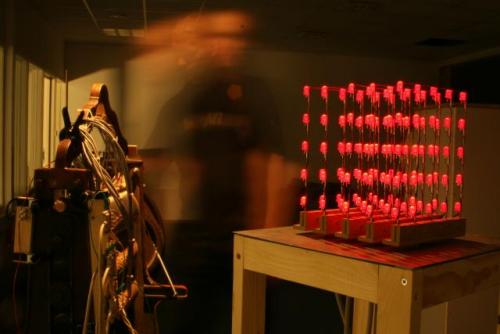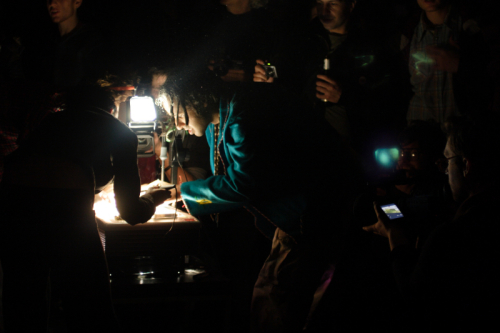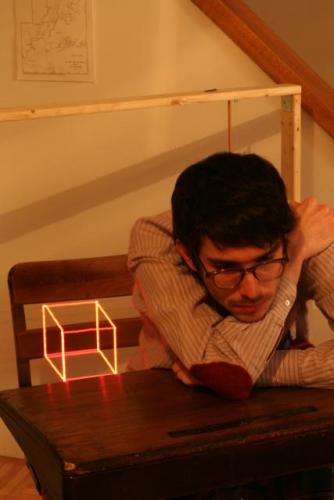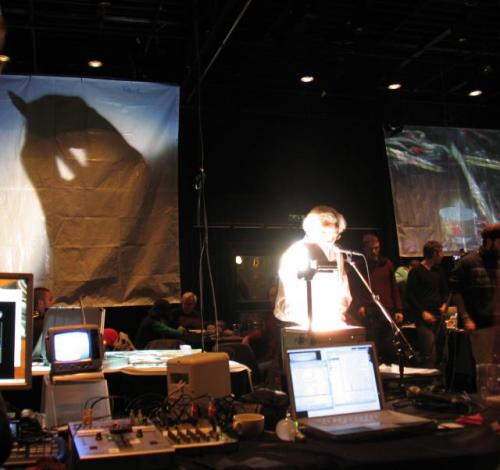Code Dreams are Made of This
This year’s Piksel festival celebrating ‘Code Dreams’ saw the boundaries between artists, audience, hardware and software blur in the collective pursuit of a machinic unconscious, as well as a highly conscious celebration of FLOSS culture. Review by M. Beatrice Fazi
What does code dream? Asking this question presupposes not only machinic consciousness but, above all, agency. What are our dreams of code? Answering this involves collective propositions for cultural techniques and models of production. Piksel08 festival investigates both – in between logics of source code, quests for artistic freedom and the beautiful scenario of a cold Norwegian winter.

Image: Øyvind Mellbye, Hologram, Piksel08, Bergen, 2008
Piksel (http://www.piksel.no ) is an annual event for practitioners and theoreticians working with free/libre and open source software [FLOSS] and hardware. Artists, developers and programmers meet annually in Bergen, Norway, to exchange opinions, bits of code, and to present their latest projects. Born in 2003 as a meeting space around the collaborative work of Gisle Froysland and Carlo Prelz on the real-time video-processing application MoB, across its six editions Piksel festival has evolved from a small workshop environment into a diverse international gathering, which includes live events, exhibitions, seminars, performances and discussions on the aesthetic and ethical implications of FLOSS culture and production.
While for the last couple of years the programme had focused on the politics of hardware – both in terms of hackability and potential for independent artistic expression – in 2008 Piksel went back to its ‘roots’ and chose as its main narrative thread the oneiric agency of coding, with the title ‘Code Dreams’. Nevertheless, from the very beginning of the festival it seemed evident that this decision did not mean looking back or returning to positions that might have lost part of their momentum today, due to the ever evolving nature of technical and social contingencies. Rather, this renewed attention to code – as a methodology of investigation, an operational perspective and a fundamental key to digital art – proved to have been a carefully considered and mature decision. ‘Code’ is not understood as pure syntax but as a necessary continuum between material consistency and semantic notation, in both cases politically and aesthetically charged. Piksel08 showed a conceptual coherence that is surely the fruit of experience and has benefited from shifts in themes and issues during the years.
Arguably, dreams have played a dominant role in nearly any cultural history of the 20th century, from Freudian discourses of subconscious analysis to surrealist practices of ‘dream incorporations’, via Disney sing along songs. Today, though, at Piksel, ‘code dreams’ are the everyday magic of encrypting systems, the utopian display of mainstream technology, the promises of declining economies – hardware and software both flattened within ‘the chance meeting of a sewing machine and an umbrella’, as the festival website reads. Computation acts at many scales and degrees of description. Its ‘unconscious’ – if we still want to use psychoanalytic categories – is ‘virtual’: not the unintentional action of a notational central subjectivity but, rather, the abstract yet real processing, actualising singular, structural, semantic and physical characters. Code agency – its ‘dreams’, to return to the theme of the festival – is not articulated through dialects of consciousness and interpretation but through a new set of concepts involving relationality, dissemination, creativity. All of which affect the material models and ecologies they are made of or born within. Similarly, yet from a human perspective, any engagement with software art is then understood as a technical and social statement embedded in the contingency of cultural production, artistic research and actual hardware manipulation.
Perhaps not by chance then, the festival's opening act was performed by Loud Objects, a trio from New York who creates live, purely digital noise music by gluing Atmel chips down on plexiglass, soldering them into a power source and connecting their outputs directly to the speaker. As they explain it:
Because of the great reduction of components involved in producing purely digital sound, we found that we could build the entire instrument in a short time, live, on top of an overhead projector, for the audience to understand the entire process of our music. As a result, we get a very physical production of electronic sound. The patterns all sound different to human listeners, but they are working entirely with the two values – full voltage or no voltage, one or zero, and that's it.
Along with ‘the joy of listening to electronics go crazy as you mess with them’, Loud Objects' performance unfolded to the audience what appears to be the really innovative kernel of interest and concern of Piksel08, namely the interplay between the openness of both software and hardware within the context of free distribution of knowledge that FLOSS culture champions. Asking for a certain level of engagement with the actual operations of open electronics stripped to their bare essentials, then, turns interactivity itself into a structural and functional relation between the different layers of action present in coding, processing, programming and – why not? – soldering. Loud Objects performance was powerful, both visually and aurally. More significantly, it exemplified in style the aesthetic of improvisation and playful vulnerability that informs not only the Piksel festival but also many possibilities, and calls for interaction in free and open software environments.

Image: The Loud Objects, Bent Festival, New York, 2007
In conceptual continuity with this discourse was another live act of particular interest – Christopher McDonald's performance, Gertrude. On stage, a machine consisting of a polycarbonate frame, stepper motors, timing belts and microcontroller-based electronics – all specifically designed and programmed – moved a tricolor LED back and forth and rendered an image of a dinosaur, pixel by pixel, while the artist stood as still as possible with his hand outstretched towards the appliance. In front, the shutter of a medium-format Polaroid camera (also modified to take the necessary 25 minute-long exposure) was first opened and consequently closed at the end of the performance, so that the machine could draw or print (‘neither word seems fully appropriate’, says Christopher) unexpected photorealistic 24-bit images. As the artist comments:
Despite the minimalism of the performance I like to think the audience experience is quite rich. This is where the piece becomes interactive. There is no narrative I attempt to convey through the performance; instead, each audience member's curiosity and gradual realization as to what the machine is doing constitutes the narrative trajectory of the experience.
Far from explicit invitations to interact, the climax of the Gertrude performance came when the audience began to figure out that the machine was actually sketching something and not just slowly moving and changing colours. Along with questions about the articulation of the analogue and the digital, the nature of visual realism and the artfulness of a project that relies heavily on its physical limitations, Gertrude thus stood as a clever critique of much media studies and art rhetoric and their promises of interaction, which often turn out to be nothing but semi-authoritarian relationships, whether between the artist and the audience or the product and the market.
Needless to say, a different understanding of participation is one of the central themes of free/libre and open source culture. Both through the common acceptance of the idealistic nature of Free Software or the more pragmatic connotations of Open Source, FLOSS advocates freedom and creativity as not constrained to objects per se, but mutually dependent on social processes and their economical, technological or ethical manifestations. Theories about technology are contingent mechanisms that inform the creation of media artifacts. FLOSS, then, is particularly interesting as it proposes a model for the relationship between artist, artifact and audience that looks at the medium as an integral part of the artistic practice. Artists are in charge of the instruments for their own expression. Similarly, the free distribution of the artwork (both as content and as medium) opens up aesthetic research to a whole community, whose legacy of ideas, fears and hopes informs not only the work but the artistic identity itself.
This is, in brief, also the main philosophy and rationale behind an event like Piksel. Artists, programmers and theoreticians gather and tighten those collaborative professional and amicable relationships which, in turn, originate from, or result in, actual participative work. In addition to exhibiting or performing, Piksel08 participants exchange opinions and introduce their latest efforts also through workshops, seminars and debates. In this sense, particularly interesting this year was the Open Business Design section and the discussion between media theorist Florian Cramer and programmer Egil Moller on the financial and economical perspective of FLOSS. Can a developer earn his living by coding freely and openly? Is FLOSS – with its own models of legalism and proceduralism – a mature alternative for today's markets? These were only a few of the many engaging questions raised and investigated during the debate.

Image: Christopher McDonald's, Gertrude, Piksel08, Bergen, 2008
Various software developments were also presented at the festival, all showing how writing code is a creative work whose effects turn out to be causes for other, parallel, collateral or independent, artistic production. Animata, for instance, is an animation software developed by Peter Nemeth, Gabor Papp and Bence Samu whose peculiarity consists in giving movement to figures and backgrounds in real-time. In contrast with more standard 3D animation programs, the environment is quite intuitive and immediate. Animata can efficiently be connected with different external applications in order to make it possible to use such pieces of software also for image processing, motion capture or sound analysis. This software can be regarded as an artistic work in itself. Similarly, though, by enabling a different set of users to be creators of their own tools, the work stands in between different layers of production and use.
Examples presented at Piksel08 of software developments as cultural networks with aesthetic and material qualities included, among others, the Gmerlin audio-video decoder (whose project leader and main programmer is Burkhard Plaum), the digital disc jockey tool Data Jockey (by Alex Norman and in premiere release at the festival) and Fritzing, an open-source initiative from the Interaction Design Lab at FH Potsdam that – in the spirit of environments such as Processing or platforms like Arduino – aims to support designers and artists in the step from physical prototyping to actual production.
Paraphrasing Mick Jagger, Friedrich Kittler once wrote that instead of what he wants, the user only ever gets what he needs1. The Jelly project – by Kunal Gupta and Tristan Perich – demonstrated that this lesson has been absorbed and productively elaborated from a philosophical attitude into a ‘dynamic content management system’ that proves to be a viable alternative to the Web 2.0 industry standards. ‘Jelly started from the interface perspective’, explains Kunal, ‘both Tristan and I would essentially develop what we thought were custom, very usable content management systems for our web development clients.’ Realizing that this efficiency could be successfully generalised, Jelly was subsequently developed into a free and powerful web development toolkit for both amateurs and professionals. He continues:
There has not been a user-generated revolution and there won't be one until the same ‘revolutionary’ users of Web 2.0 services are able to create social tools to organize around the issues they care about themselves. There is no longer a technological reason why normal web users cannot have nearly the same power to produce website tools as programmers – we just need interfaces that are designed well enough for such average users to feel free and creative as they play with and imagine the Internet.
These enabling tools were a promise that Web 2.0 clearly stated in its premises, by aiming to help consumers to produce and share their content. ‘Now Jelly is just taking the tiny, but far more politically substantial, next step.’
At this point, it is clear how FLOSS cult and culture are structurally and operatively concerned with what can be exchanged, whether information, noise or control structures. In such a context, live coding is another aspect of the artistic practice of programming that aims to uncover all the different hierarchies of abstraction taking place in computational environments. Being, in few words, nothing but code written on the fly, executed and rewritten during the performance, live coding as artwork expresses and enacts code as a form of cultural production that exposes its normally obscured materials. Fascinating examples of live coding at Piksel08 were Iohannes M. Zmolnig's Do Sinusoids Dream of Electric Sweeps? and No Copy Paste by Agoston Nagy and Gabor Papp. Both performances showed how the synthetic power of computation is, effectively, an expressive structure, depending on the improvisational ability of the programmer/performer to relate material production and formal scripting.
Coding was again the protagonist of the two main events covering the whole of Saturday at Piksel08. The Real Code subsection was created by xxxxx. ‘This was the third sub-event we organised as part of Piksel’, says Martin Howse, who also co-curated the festival. Jonathan Kemp adds: ‘We moved structurally from the performative to social software events. All, however, made with an eye on constructing environments through low level usable abstraction.’ During the 12-hour session, xxxxx at Piksel08 aimed to use coding as a material, linguistic and descriptive means. Real code is, in this sense, ‘constructive’: it makes things happen and fabricates worlds. ‘The event could be described as a practical attempt to manifest this so-defined life coding through various experiments in the self-organisation of systems and lack of imposed structure’, continues Martin. The numerous groups of participants – artists, programmers, scientists and, in fact, most of Piksel’s attendants – created a kind of ‘island’ (the event itself), in turn defined by smaller constructions (the experiments of each attendant) and their mechanism of intercommunication. This experimentation included fish farming, the creation of electromagnetic anomalies, data forensics, the mapping of seismic intensities, literal piping, lightwave communications, interviews, microwave studies and cooking lab, historical cable reconstruction and the documentation of imperceptible information.

Image: Otto Rossler, Real Code, Piksel08, Bergen, 2008
Thanks to all these activities simultaneously taking place, ‘real code balanced out its own structuring through environmental contingencies made on the fly. So from a limited set of hard components, several live and executable actions are made’, Jonathan explains. Otto Rossler was a key presence of the day. Medical doctor, biochemist, nuclear scientist and chaos theorist, Rossler is all this but also – and this is what really came across, above all the titles – a genuinely wise and enthusiastic person. ‘The spirit of science is at work here’, he said during his keynote talk, ‘for science is an island-type patchwork’. Science is art and there is no contradiction between being an artist and working as a scientist. ‘I change fields every ten years! So you force yourself to become young again’, he humorously advised, noticing how he was probably the only person in the room with grey hair. Just like in ‘endophysics’ – the scientific field that Rossler himself founded – observations and processes of encryption/decryption at the Real Code event were affected and somehow limited by the experimenter being within the same ‘universe’. This fact, though, did not undermine their validity but, rather, showed all their operational strength.
At the midnight stroke, Real Code came to an end and gave place to its Abstract counterpart, the second subsection of the festival organised by the other Piksel08 co-curator, Eleonora Oreggia. ‘Abstract Code is a research on different types of text’, she illustrates. ‘Source code is a special type of textuality because it engenders a fluid mechanism that transforms "simple text" into a more complex entity, which in turn can trigger certain events or actions.’ The question specific to the Abstract Code event, then, was: what other types of notation do we know and experience that, in a similar fashion, are capable of triggering, manipulating and generally affecting reality? Examples of this coding are maledictions, oracles, refrains, iambi, hymn, oracles, formulas, hypnotic sentences, prayers – encryptions that are ‘procedural’ and thus capable of becoming invisible, magic, semantic and superstitious acts. From midnight to dawn, the Abstract Code subsection at Piksel08 celebrated this research through a party, Catacstrobe, which Eleonora defines as ‘an interesting experiment, an attempt to drag the free spirit of the authentic psychonauts and the early techno movement, and their idea of social and open consciousness, together with the free software techniques.’ Most interestingly, the event was articulated through actual presence and the use of streaming technologies and chats with a parallel social gathering, so as to unite participants performing locally (GOTO80, Gaia Novati, Gijs Gieskes, Pixa Babel, One Man Nation and Xname) and remotely (Simon Yuill, Isjtar, Alex McLean, Glerm Soares, Sister0 and Kiki Jaguaribe) and cut across different types of space and action.
The varied nature and purposes of Piksel08 make the event immune from any sort of exhaustive review. Other participants at the festival included Julian Oliver, Jessica Rylan, Julien Ottavi, Pall Thayer, elpueblodechina together with Bureau d'Etudes, to name but a few. They all, through different expressive means, articulated code as an interplay between computational realities, social substrata and situated economic and political agents. As Piksel08 showed at the end, code dreams are, fundamentally, made of this. When technology becomes hackable, interrogable and open, dreams are no longer internalist hallucinations or wishes a la Descartes, but collective enunciations for art and life, in all their reciprocal complexities.
M. Beatrice Fazi < b.fazi AT me.com > studies humans and machines and finds both of them quite beautiful. She is currently a PhD candidate, in the field of interactive aesthetics and continental philosophy, at the Centre for Cultural Studies, Goldsmiths
Info
Piksel08 festival ran from 4 – 7 December 2008 in various venues in Bergen, Norway. The exhibition is open till the 25 January 2009 at Galleri 3,14, also in Bergen. For more info visit http://www.piksel.no
Footnote
1 Friedrich Kittler, ‘Protected Mode’ in Literature, Media, Information Systems, New York: Routledge (1997), pp.156-168.
Mute Books Orders
For Mute Books distribution contact Anagram Books
contact@anagrambooks.com
For online purchases visit anagrambooks.com






